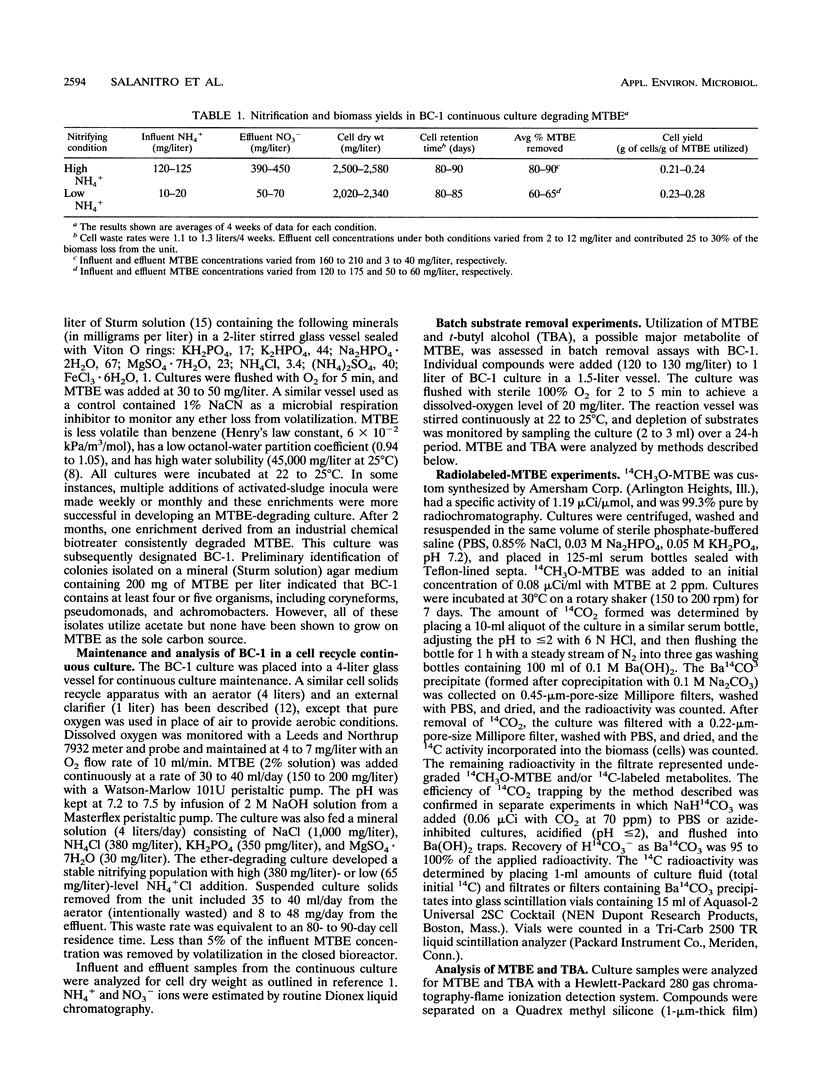Abstract
We have isolated a mixed bacterial culture (BC-1) which is capable of degrading the gasoline oxygenate methyl t-butyl ether (MTBE). BC-1 was developed from seed microorganisms present in a chemical plant biotreater sludge. This enrichment culture has been maintained in continuous culture treating high concentrations of MTBE (120 to 200 mg/liter) as the sole carbon source in a simple feed containing NH4+, PO43-, Mg2+, and Ca2+ nutrients. The unit had a stable MTBE removal rate when maintained with a long cell retention time (ca. 80 to 90 days); however, when operated at a ≤50-day cell waste rate, loss of MTBE-degrading activity was observed. The following three noteworthy experimental data show that MTBE is biodegraded extensively by BC-1: (i) the continuous (oxygen-sparged) culture was able to sustain a population of autotrophic ammonia-oxidizing bacteria which could nitrify influent NH4+ concentrations at high rates and obtain CO2 (sole carbon source for growth) from the metabolism of the alkyl ether, (ii) BC-1 metabolized radiolabeled either (14CH3O-MTBE) to 14CO2 (40%) and 14C-labeled cells (40%), and (iii) cell suspensions of the culture were capable of degrading (substrate depletion experiments) MTBE to t-butyl alcohol, a primary metabolite of MTBE. BC-1 is a mixed culture containing several bacterial species and is the first culture of its kind which can completely degrade an alkyl ether.
Full text
PDF



Selected References
These references are in PubMed. This may not be the complete list of references from this article.
- Liaw H. J., Srinivasan V. R. Molecular cloning and expression of an Erwinia sp. gene encoding diphenyl ether cleavage in Escherichia coli. Appl Environ Microbiol. 1989 Sep;55(9):2220–2225. doi: 10.1128/aem.55.9.2220-2225.1989. [DOI] [PMC free article] [PubMed] [Google Scholar]
- Meyers A. J., Jr Obligate methylotrophy: evaluation of dimethyl ether as a C1 compound. J Bacteriol. 1982 May;150(2):966–968. doi: 10.1128/jb.150.2.966-968.1982. [DOI] [PMC free article] [PubMed] [Google Scholar]
- Oremland R. S., Culbertson C. W. Evaluation of methyl fluoride and dimethyl ether as inhibitors of aerobic methane oxidation. Appl Environ Microbiol. 1992 Sep;58(9):2983–2992. doi: 10.1128/aem.58.9.2983-2992.1992. [DOI] [PMC free article] [PubMed] [Google Scholar]
- Sturm R. N. Biodegradability of nonionic surfactants: screening test for predicting rate and ultimate biodergradation. J Am Oil Chem Soc. 1973 May;50(5):158–167. doi: 10.1007/BF02640470. [DOI] [PubMed] [Google Scholar]
- Tonge G. M., Harrison D. E., Higgins I. J. Purification and properties of the methane mono-oxygenase enzyme system from Methylosinus trichosporium OB3b. Biochem J. 1977 Feb 1;161(2):333–344. doi: 10.1042/bj1610333. [DOI] [PMC free article] [PubMed] [Google Scholar]
- van den Wijngaard A. J., Prins J., Smal A. J., Janssen D. B. Degradation of 2-Chloroethylvinylether by Ancylobacter aquaticus AD25 and AD27. Appl Environ Microbiol. 1993 Sep;59(9):2777–2783. doi: 10.1128/aem.59.9.2777-2783.1993. [DOI] [PMC free article] [PubMed] [Google Scholar]


